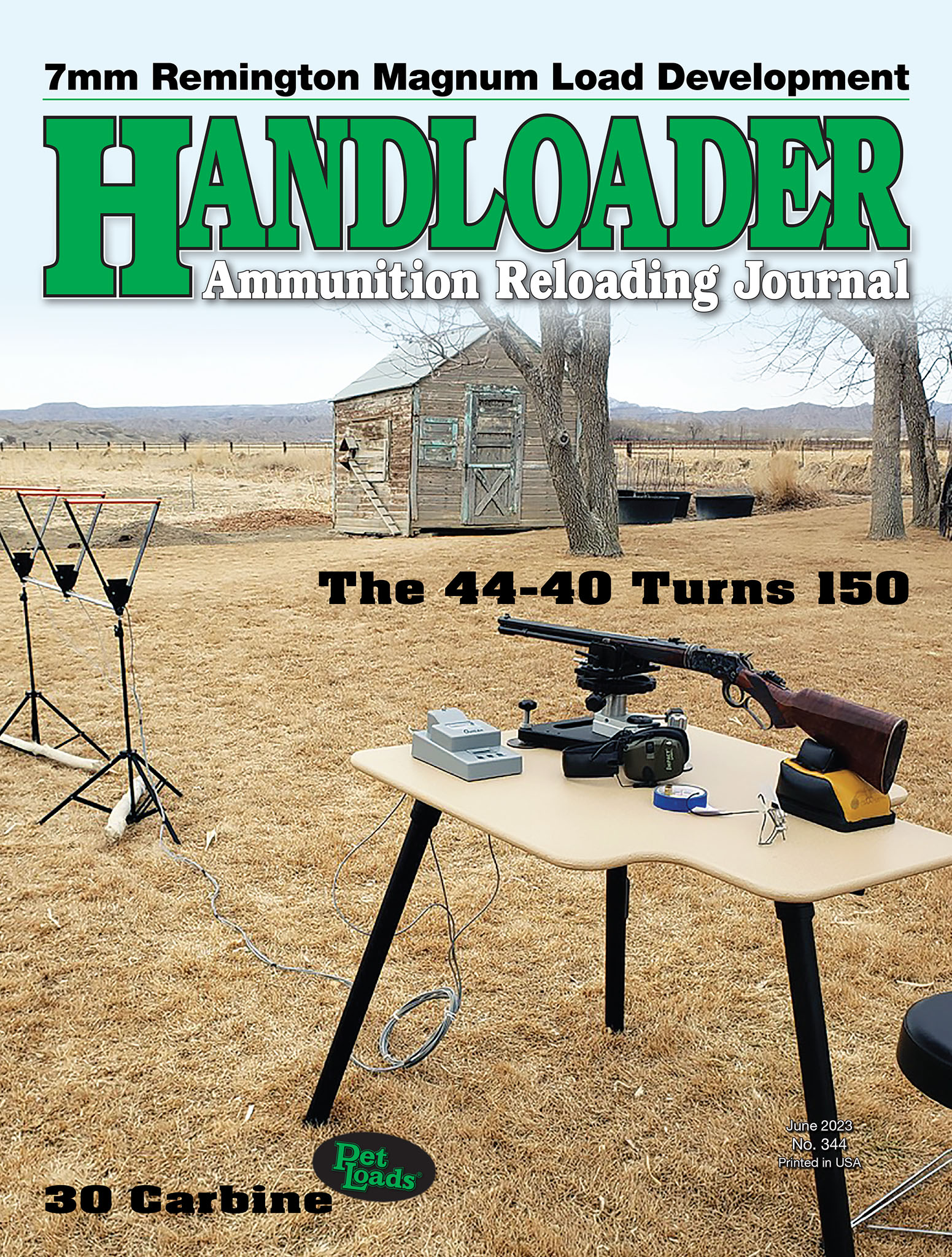
A Stevens Model 45 “Ideal Range” built on a No. 44½ action.
Since its introduction by Remington and Ruger in 1983, the 357 Maximum has not set the world on fire. It was one of those cartridges that seemed like a good idea at the time, but in practice, presented so many problems it was either soon dropped or ignored altogether.
The Max is simply the 357 Magnum case lengthened by .310 inches, allowing more powder capacity and a heavier bullet. Reportedly, the original conception was a revolver cartridge that would give silhouette shooters more punch on steel targets at longer ranges, and its first chambering was in a Ruger Super Blackhawk single action.

Stevens Model 45, with an original Stevens Model 104 tang sight.
In theory, this lengthening merely extended the process begun when the 38 Long Colt was lengthened to create the 38 Special, and the 38 Special lengthened further to create the 357 Magnum. Unfortunately, the final step to the 357 Maximum created problems with high pressures and gas-cutting of top straps and it was abandoned.
It might have had some rifle applications, but in 1983, the market for midsized .35-caliber cartridges tossing midweight bullets at modest velocities was nil and it languished except in the odd barrel for guns like the Thompson/Center Contender. A few 35-caliber lovers imagined it in a slick lever action along the lines of the Winchester ’92, figuring it would create a medium-game cartridge not much inferior to the 35 Remington, and certainly better than the 357 Magnum, but neither Winchester nor Marlin took the bait.

A Stevens 104 “Mid-Range” vernier tang sight, with a Hadley eye cup.
There was one use, however, for which the 357 Maximum should have been perfect: A good single-shot falling block in the tradition of the Winchester Low Wall or the Stevens 44½.
As it happened, I have a lovely Stevens Model 45, with the strong No. 44½ action, acquired, almost by accident, at an auction. It’s chambered for the 28-30-120, a target cartridge introduced by Stevens around 1900, and while it is possible to get components and load ammunition for that, it’s considerably less than convenient.
One major virtue of the Stevens Ideal series from 1894 to 1916 is that the barrels are held in coarse threads, tightened with hand pressure and locked in place with a substantial set screw. This allows easy removal for cleaning – very important in the days of black powder and lead fouling. It also means you can switch barrels readily and additional or replacement barrels are relatively easy to make. One hitch is the extractor, which is a separate piece made to fit a particular rim. Of course, you could have additional extractors made, but it complicates things. Keep to the same rim diameter and there is no need for a second extractor.

These cartridges all have small magnum pistol primers, which proved too soft for 357 Maximum pressures. The primers that are not actually pierced show indications of excessive pressure in that they are bulged out almost to bursting point.
By coincidence, the 357 Maximum has a rim diameter within ten-thousandths of the 28-30-120 – a mere nothing in extractor terms, which means that a barrel chambered for that cartridge would allow me to also shoot readily available 38 Special, if I felt like an afternoon of plinking. At the same time, I could maintain the rifle in the very fine, completely original, condition in which I bought it, without compromising its historical and collector value by one whit.
Lee Shaver, of Lamar, Missouri, made and fitted a 28-inch barrel for the Stevens. We retained the original Stevens tang sight and installed one of Lee’s globe front sights on the new barrel.

The new 357 Maximum barrel will accommodate (left to right) 38 Special, 357 Magnum and 357 Maximum loads.
With factory 38 Special and 357 Magnum, the rifle shoots just fine, but while I wanted 38 Special for plinking, my main goal was to create some 357 Maximum loads for hunting, for 200-yard targets, or even using black powder and lead bullets for some vintage competitions. Here is where the 357 Maximum revealed its true, treacherous nature.
The Stevens 44½ action is a very strong falling block, and has a fair claim to being the finest of all the American single shots, but it has one weakness: The firing pin strikes the primer coming up at a slight angle and it has no spring to retract it. The pin is simply cammed back out of the way by the primer itself as the action is opened – in theory. In practice, if the pin sticks in the primer for whatever reason, forcing the action can break the pin.
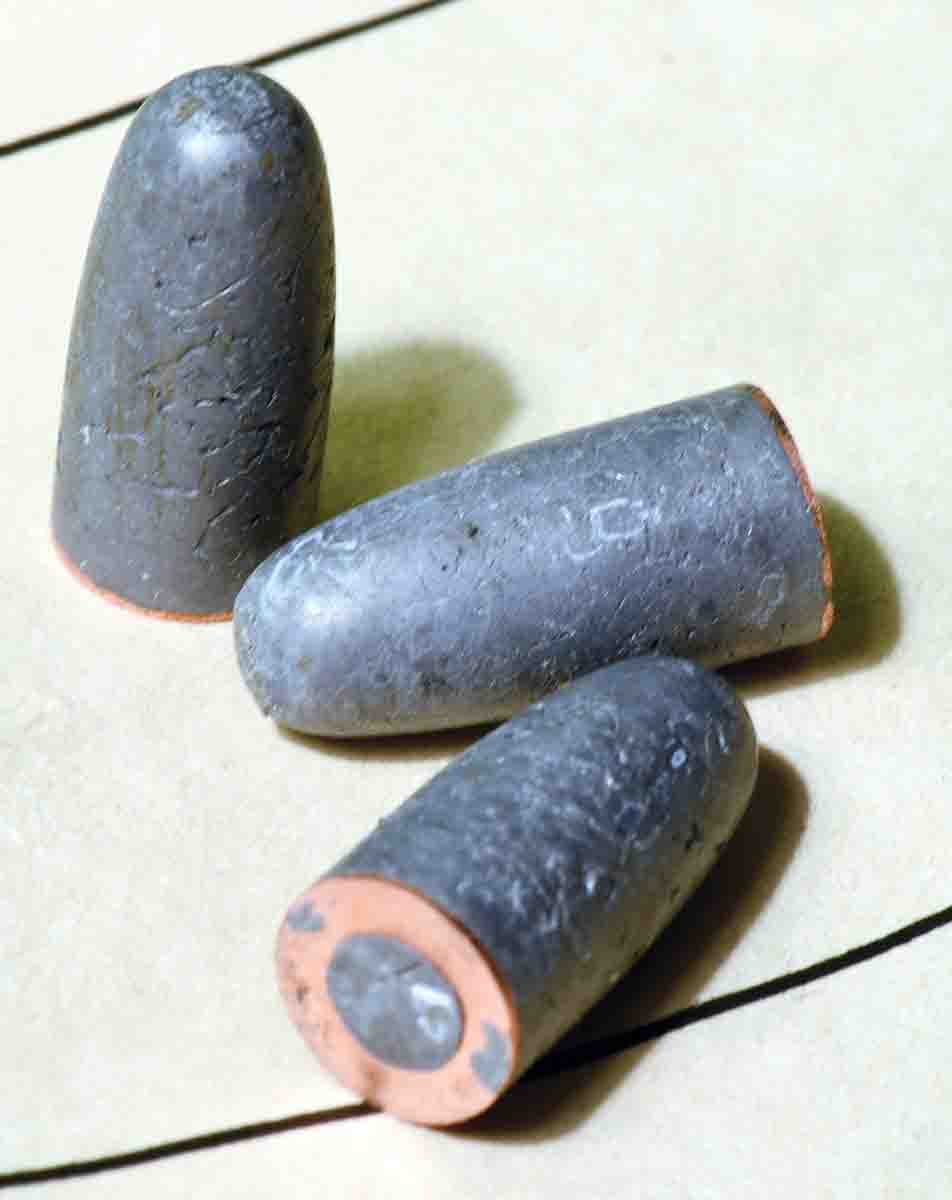
Bill Noody’s (Northern Precision) 180-grain, .358-inch cast bullets fitted with his “base guard.” The base guard performs much the same purpose as the traditional copper gas check, while also, Bill said, scraping and cleaning the bore with each shot.
Ned Roberts noted this in
The Breech-Loading Single-Shot Rifle (
Wolfe Publishing, 1987) and wrote that gunsmiths such as A.O. Niedner, had come up with a solution involving a new pin, a bushing for the breechblock and a retractor spring. Roberts owned and used many 44½, and even used one in the development of his high-pressure .257 Roberts cartridge. (Just a surmise, but he wrote about the many different barrels he tried as he experimented with length and shoulder angle. The Stevens action would simplify this considerably.)
Roberts also wrote that he had considerable trouble with broken firing pins, sometimes breaking one or two at a shooting session, but after he had all his 44½ actions reworked with the bushing, spring, and smaller pin, the problem disappeared.
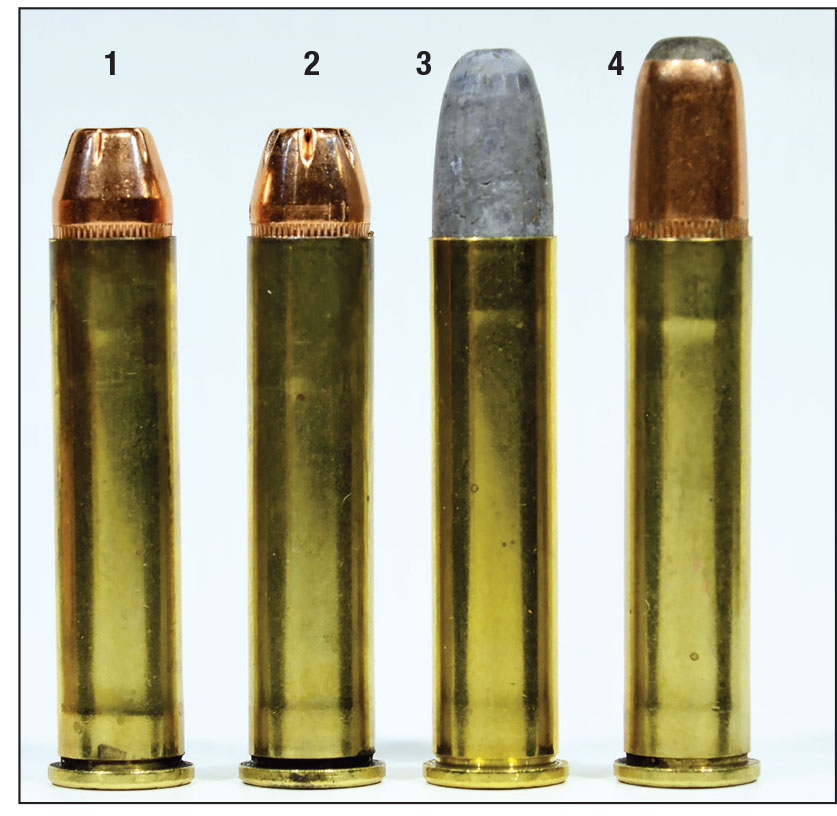
The four loads settled on were loaded with: (1) Hornady 140-grain FTX, (2) Hornady 180-grain FTX, (3) Northern Precision 180-grain cast bullet and a (4) Sierra 200-grain roundnose.
Ned Roberts died before he finished his book on single shots, and the work was completed by Ken Waters. Waters was puzzled about the broken firing pins, because he had used many Stevens 44½-actioned rifles and had never broken so much as one.
Roberts was working in the 1930s, and the guess by Waters was that the problem lay with the softer primers in use at that time. Soft primers, combined with the higher pressures of smokeless powder, can lead to perforated primers and serious sticking.
I’ve had the Roberts/Waters book for 20 years and read the passages about this problem at least two dozen times, so I should have remembered it when I started loading 357 Maximum for my Stevens. But I didn’t.
Here we get into the many complications of loading a pistol cartridge for use in a rifle.

This five-shot group, at 100 yards with the Northern Precision 180-grain cast bullet, measured 1.675 inches.
First, primers. There are distinct differences between rifle and pistol primers, the latter being softer, often in shallower cups, and with milder brisance. They are softer because the striking power of a pistol striker or hammer is generally less than a rifle. Brass for handgun cartridges sometimes – but not always – has shallower primer pockets.
All of this is possible because handgun cartridges work at lower pressures. The 38 Special, for example, typically has pressures in the range of 16,000 pounds per square inch (psi), while the hot 357 Magnum might be 33,000 psi – roughly comparable to the mild-mannered 35 Remington.
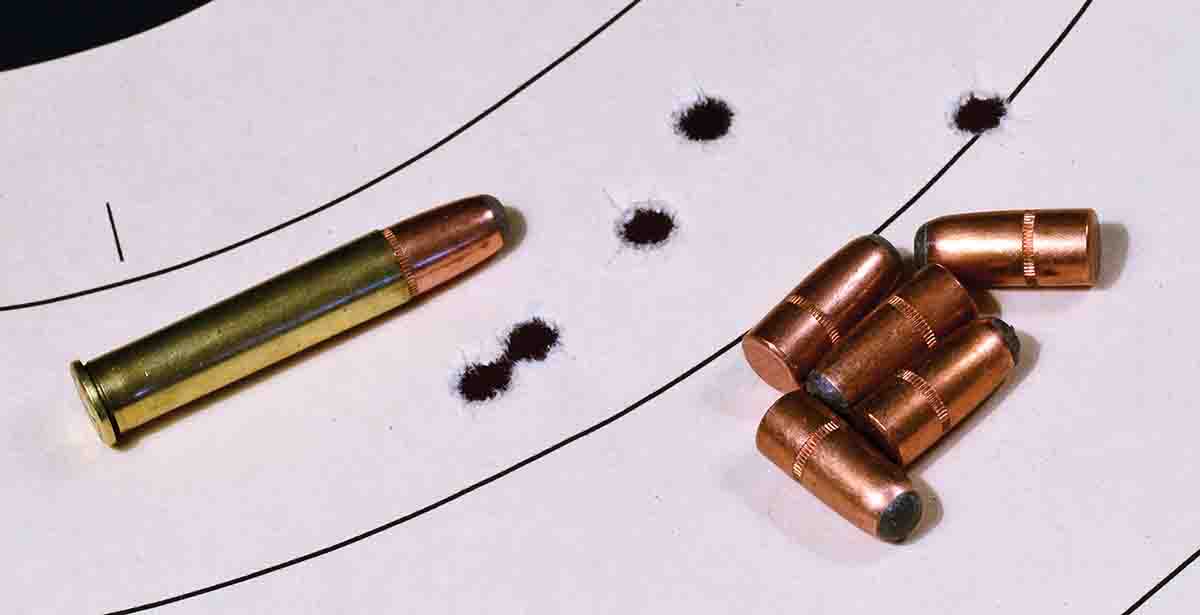
Sierra 200-grain roundnose bullets, the traditional deer bullet in the 35 Remington. Five-shot group measuring 2.7 inches at 100 yards, using original Stevens tang sight. At 1,834 fps, this would be a good short-range deer load.
Loading data for the 357 Maximum is understandably hard to come by, since it was chambered in so few guns, so long ago. There is no data from Alliant, Shooters World, or Vihtavuori. This left only Hodgdon, but since this includes Hodgdon, IMR, Winchester, Accurate and Ramshot powders, it’s not exactly a hardship. One could extrapolate loads from 357 Magnum data, but I am not a great believer in doing that except as a last resort, and even then, not publishing the results. I’m certainly not about to risk, even remotely, my precious old Stevens.
Bullets are another variable. The 357 Maximum calls for .357-inch bullets, but heavier rifle bullets are .358 inch. The extra thousandth presents no problem as far as loading and chambering, but is a potential concern when you are working with maximum or near-maximum loads. Also, handgun bullets, especially hollowpoints, are not intended for the kind of velocities one can expect from a 28-inch barrel instead of an 8- or 10-inch barrel.
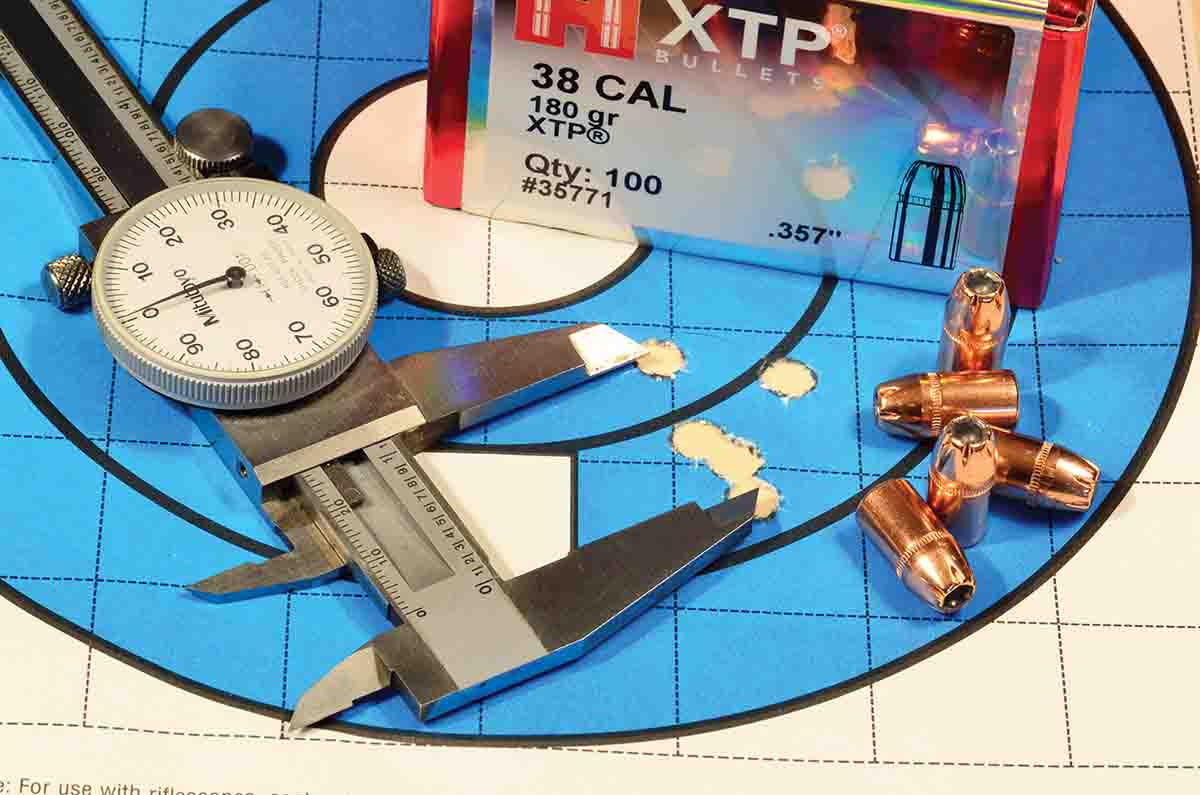
This is a test group fired at 37 yards while determining the correct aperture for the globe front sight. It measures 1.1 inches and was fired with Hornady 180-grain FTX bullets at 1,858 fps. This would be a devastating short-range pig load.
As you can see, there were an awful lot of variables at work as I began putting together my first experimental loads.
The Hodgdon data calls for small magnum rifle primers. None were to be had, so I first substituted small pistol magnums. The loads I put together were from the middle range of the data – not starting loads, but nowhere near maximum. I had already shot 15 or 20 rounds each of factory 38 Special and 357 Magnum, with no sign of any problem whatsoever. From the start, however, my handloads exhibited some worrying signs: pierced primers, the occasional gas leak, and twice, a very stiff lever indicating a stuck firing pin. I found one or more of these signs in about seven out of 10 shots.
Luckily, I emerged from this experience with everything intact except my ego. I dismantled all the remaining loads, deprimed all the prepared brass, and started over.
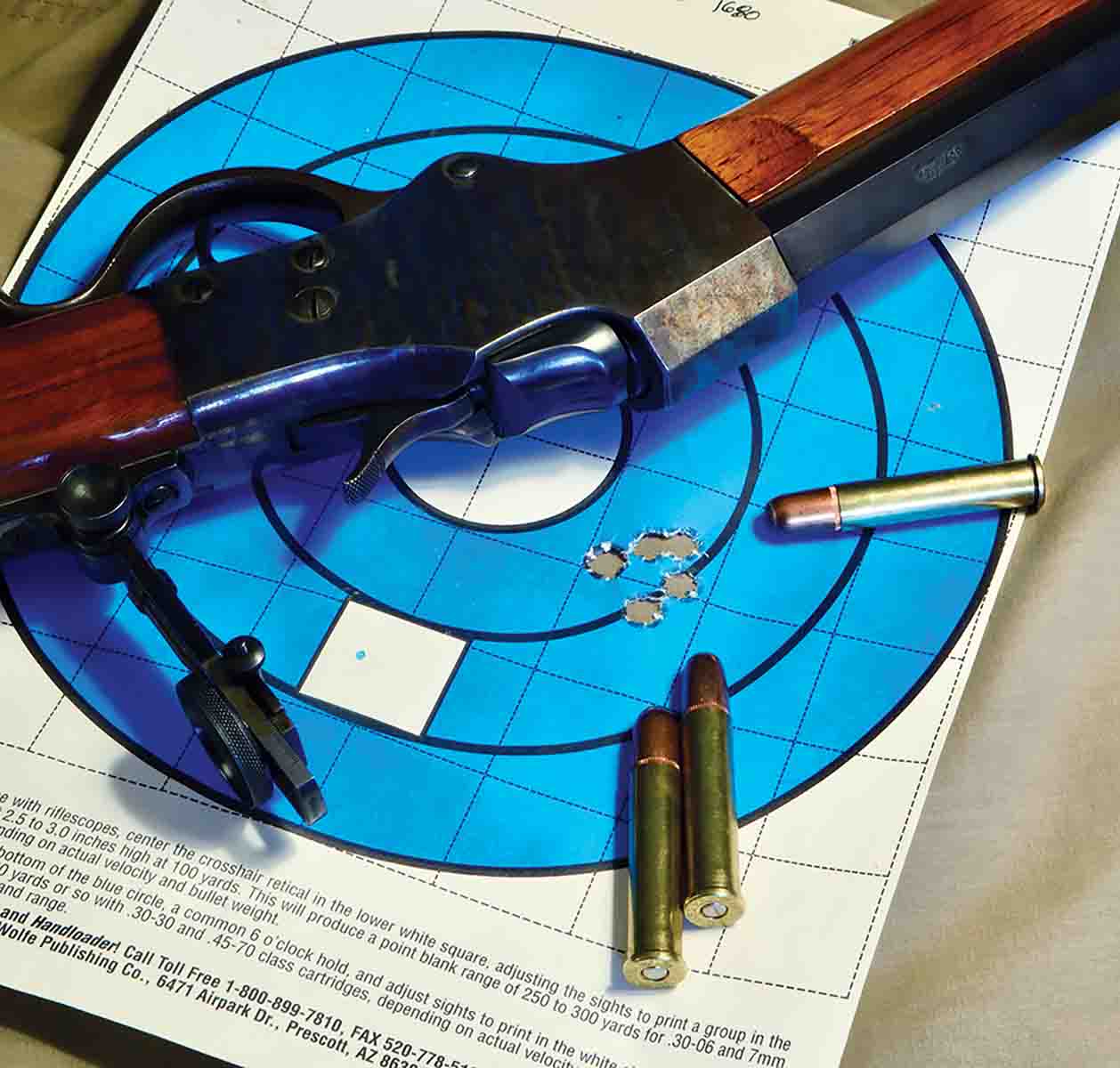
Stevens “Ideal Range” Model 45, sporting its new 357 Maximum barrel. This .722-inch group was shot at 37 yards, while experimenting with different apertures for the globe front sight. Even so, not bad for the venerable Sierra (.358-inch) 200-grain roundnose, made famous in the 35 Remington. Alas, at 100 yards, all the good, close-in groups opened up, some quite dramatically. This load at 100 yards recorded a 2.7-inch, five-shot group – still very good – with iron sights.
For the record, with those initial hot loads, I recorded a velocity of 2,447 feet per second (fps) with Hornady 140-grain XTP hollowpoint bullets ahead of a midrange load of Lil’Gun. Other bullets, ranging in weight up to 200 grains, delivered respectable velocities.
Switching to Federal Gold Medal 205M primers, I settled on three bullet weights: 140, 180 and 200, with two different types of 180s. These were Hornady XTP and Northern Precision cast bullets with what Bill Noody calls his “base guard,” similar to a conventional gas check.
A normal sequence of events in load development is to shoot a pressure series, working up to what you consider maximum, and then working down from there until you find the load that combines the best accuracy with acceptably high pressures. In this case, I had to start low and work up, always trying to avoid reaching a pressure that would cause a gas leak, a pierced primer, or – the worst case – a stuck firing pin.
Hodgdon lists data for nine different bullet weights (100 to 200 grains) using 11 different powders.
For the Hornady 140- and 180- grain XTP bullets, I settled on CFE BLK. For the Sierra 200-grain roundnosed (the traditional deer-hunting bullet in the 35 Remington) I went with Accurate 1680. The Northern Precision 180-grain cast bullet particularly liked Accurate 5744.
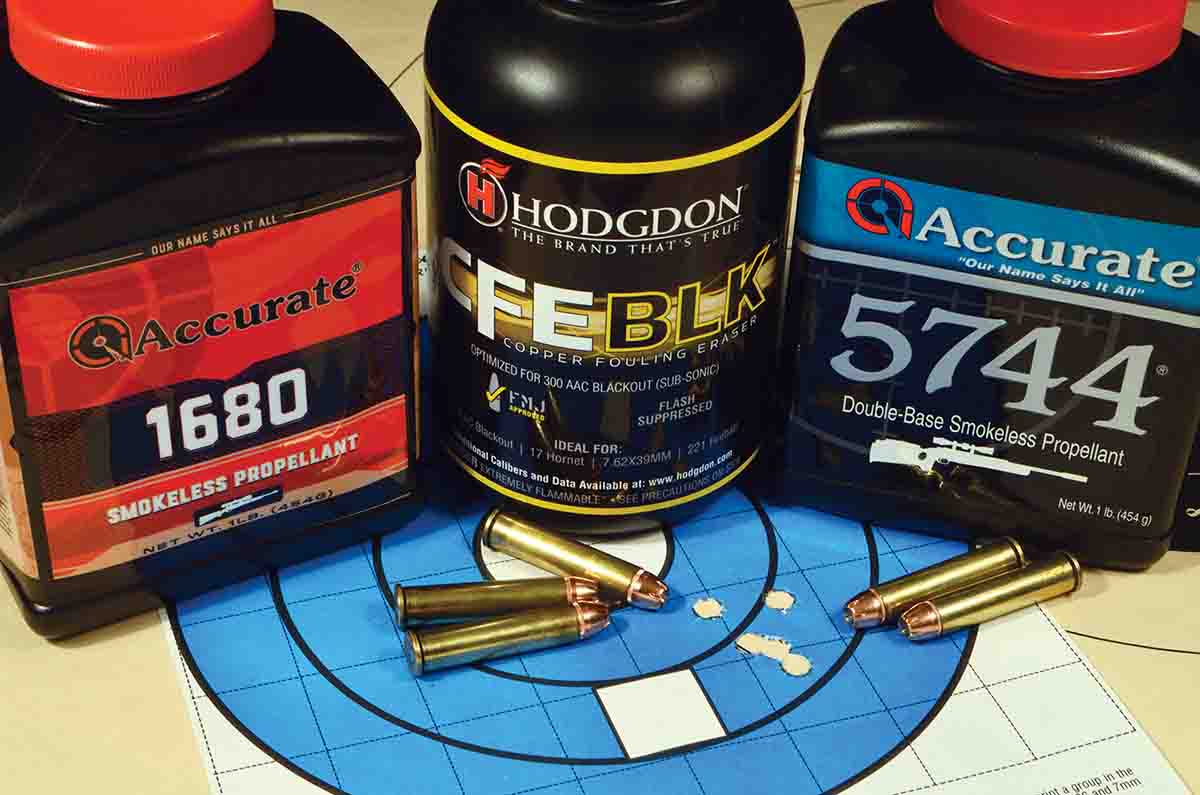
Hodgdon CFE BLK and Accurate 1680 and 5744 all delivered good performance in the 357 Maximum.
The accompanying table shows the result. In days past, with a hunting rifle, 4-inch groups at 100 yards using iron sights were more than acceptable, and this rifle bettered that standard with every load. For some reason, it consistently delivered five-shot groups around an inch at 37 yards, the distance I was using for adjusting the sights and figuring out what aperture to use, but they then opened up. This would be, at best, a 150-yard hunting rifle, so that doesn’t worry me unduly.
In my experience, there are two sweet spots for accuracy: very mild loads, and close to maximum. Since anything close to maximum is ruled out because of the concern about pierced primers, I am limited to fine-tuning accuracy loads at the lower levels. Meanwhile, there’s really nothing wrong with the results I’m getting now.
For the record, in the 28-inch barrel, factory 38 Special and 357 Magnum ammunition I’ve tried consistently delivers velocities 300-400 fps greater than is called for by the manufacturers in 8- or 10-inch barrels.
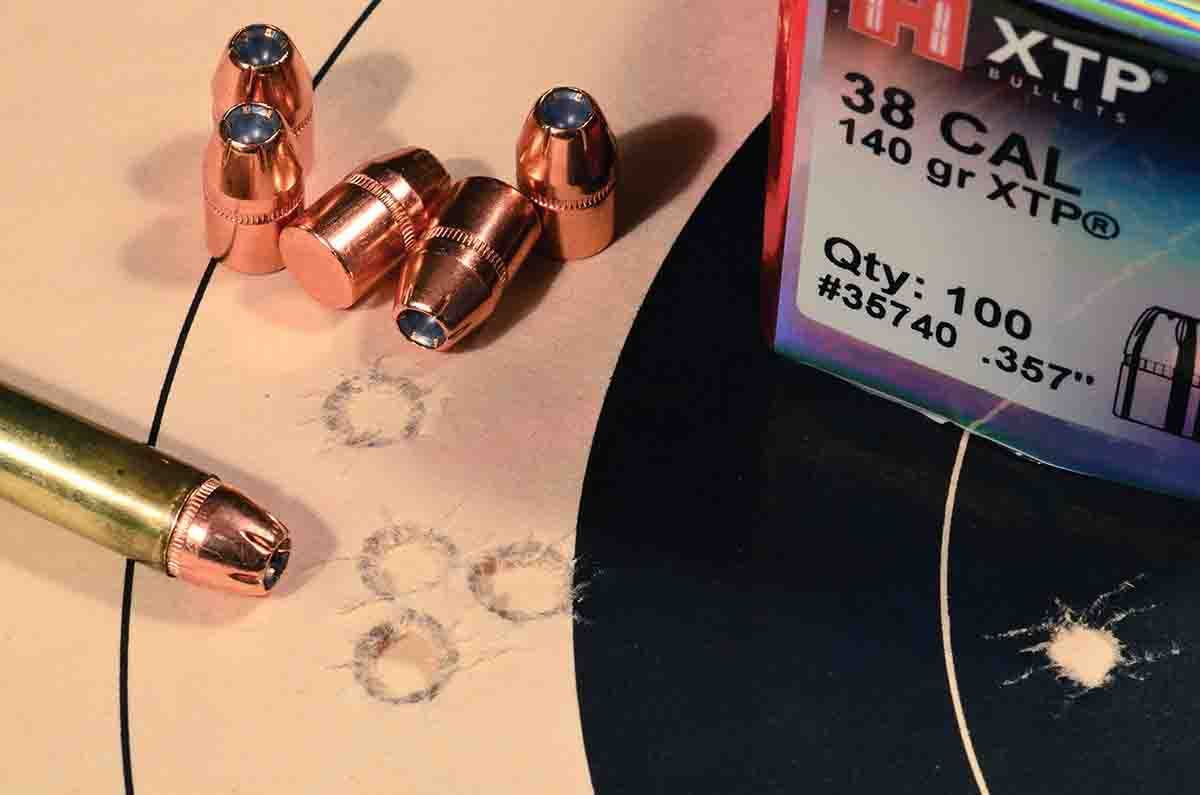
Too bad about the flyer, which stretched the group from 1.1 inches (four shots) to 2.6 inches for five. This was shot with Hornady 140-grain FTX bullets at 2,002 fps.
Overall, I can’t say the experiment with the 357 Maximum was a glowing success, and I expect I’ll end up shooting more 38 Special in it than I will 357 Maximum. In a different rifle, however – a Winchester Low Wall, say, or a Stevens 44½ with the Niedner modification – the 357 Maximum could be a real barn burner. Two of my early loads, well within safe specifications but with pierced primers, launched the Hornady 140-grain FTX at 2,447 fps, and the 180-grain FTX at close to 2,000 fps. How those handgun bullets would hold up at those velocities is another matter, of course.
Both the Sierra 200-grain roundnose and the Northern Precision 180-grain cast bullets would be just fine at their respective velocities, and the accuracy is excellent as well.
Between the 28-30-120 barrel, and the new barrel that will handle everything from 38 Special plinking loads to the 357 Maximum for deer and such, the old Stevens Model 45 has become a genuine multi-purpose rifle.













.jpg)


